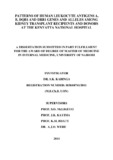| dc.description.abstract | Background
Tissue typing is important in allogeneic haematopoietic stem cells and organ transplantations.
Human leucocyte antigen (HLA) matching plays a major role in graft rejection and survival.
Kidney transplantation is the best treatment for patients with end stage kidney disease. Tissue
typing for HLA –A, -B, -DRB1 and –DQB1 genes and cytotoxic T cell cross-match are done
for the every patient and potential donors. There has not been local data of the pattern of
these genes and alleles among this population.
Aim
Owing to the need for tissues typing among the kidney grafts donors and recipients which has
a running programme in the Kenyatta National Hospital, our study described the pattern of
the Human Leucocyte Antigens (HLA) –A, -B, -DRB1 and –DQB1 genes and alleles among
the donors and recipients.
Objectives
Primary objective: To determine the frequencies of human leukocyte antigens A, B, DQB1
and DRB1 genes and alleles among kidney transplant recipients and donors in Kenyatta
National Hospital
Secondary objective: To describe the frequencies of specific HLA genes and alleles
associated with:-, Type 1 diabetes (DRB1*03, DRB1*04, DQB1*02), Rheumatoid arthritis
(HLA-DRB1*04, HLA-DRB1*01, HLA-DRB1*10), Systemic lupus erythematosus
(DRB1*03 and HLA-B*15), Ankylosing spondylitis and acute anterior uveitis (HLA-B*27),
Behcet’s disease (HLA-B*51), Abacavir hypersensitivity (HLA-B*57) in the kidney
transplant recipients and donors at the Kenyatta National Hospital.
Method: The study was cross-sectional, retrospective descriptive study. Two hundred and
sixty nine (269) individuals’ records were studied. This comprised of 134 kidney transplant
recipients and 135 kidney transplant donors. The HLA class I (HLA-A, HLA-B) and class II
(HLA-DRB1, HLA-DQB1) genes and alleles were analysed.
Results: There were 269 individuals with 134 being kidney recipients while 135
were donors. A total of 21 HLA-A alleles were demonstrated among donors and recipients.
The commonest alleles were HLA- A*02 (19.4%), -A*01 (10.78%), -A*30 (10.41%), -A*28
(9.48%), and –A*24 (5.20%). HLA-A*--, which meant that the alleles could not match any of
the known alleles in the alleles bank contributed 7.62%. The distribution of HLA-A alleles
among the kidney transplant donors and recipients had similar patterns. HLA-B gene was the
most diverse in and total of 35 alleles were found. HLA-B alleles which showed frequencies
above 5% included: - HLA-B*17 (14.13%), -B*07 (11.52%), -B*--, (9.11%) (No allelic
match found from the alleles bank), -B*53 (8.92%), -B*15 (6.13%), -B*49 (5.76%) and –
B*70 (5.58%). The distribution of HLA-B alleles among the kidney transplant donors and
recipients had similar patterns. There were eighteen (18) alleles at HLA-DRB1 gene. Four
alleles contributed more than 1 0% each. The alleles with frequency of more than 5% included
HLA-DRB1*11 (20.92%), -DRB1*13 (16.36%), -DRB1*03 (15.80%), -DRB1*15 (10.41%),
-DRB1*07 (5.76%), -DRB1*01 (5.58%) and -DRB1*04 (5.02%). At HLA-DRB1, 8.55% of
the population could not match any alleles in the allelic bank. Among the kidney recipients a
total of 16 alleles were detected while among the donors, 17 HLA-DRB1 alleles were
detected. The commonest HLA-DRB1 alleles were similar among the donors and recipients.
At the HLA-DQB1 genes, there was the least diversity when compared to other HLA-genes.
There were eleven (11) alleles in the HLA-DQB1 gene. The first six contributed more than
80% of the study population. Five alleles had frequencies of more than 5%. They included
HLA-DQB1*06 (25.09%), DQB1*03 (19.52), DQB1*02 (14.87%), DQB1*05 (13.75%) and
DQB1*04 (6.13%), while DQB1*-- was reported in 18.96%. Among the kidney recipients a
total of nine (9) alleles were detected. Among the donors, eleven (11) HLA-DQB1 alleles
were detected. The commonest HLA-DQB1 alleles had similar pattern among the donors and
recipients.
For HLA-DRB1*03, -DRB1* 04 and –DQB1*02 which have been associated with type 1
diabetes, there were 184/269 (68.4%) of individuals who carried genes and alleles. There
were 84 individuals who had HLA-DRB1*03 allele. For some genes and alleles associated
with rheumatoid arthritis (HLA-DRB1*04, HLA-DRB1*01, HLA-DRB1*10), there were
81/269 (30.1%) individuals who carried A-DRB1*01, HLA-DRB1*04, and HLA-DRB1*10
alleles. One hundred and seventeen (117) 43.49% individuals studied carried the HLADRB1*03 and –DRB1*15 which are some of the alleles which have been associated with
systemic lupus erythematosus. There were six (6) 2.23% individual who carried the HLAB*27 allele which has been associated with ankylosing spondylitis and acute anterior uveitis.
There were four (1.48%) individuals in our study who had HLA-B*51 allele which has been
associated with Behcet’s disease, while another four (1.48%) individuals in our study carried
the gene and allele which has been associated with hypersensitivity to abacavir.
Conclusions: The genetic diversity at human leukocyte antigens in our population has
HLA-B gene as the most diverse while the least diversity was in HLA-DQB1 gene, a
phenomenon which has been found elsewhere in Africa, South America and Europe. HLA-A,
-B, -DRB1 and –DQB1 genes, the diversity found in our study is comparable to that found in
some populations in Europe, Central and South America. Our population is more genetically
diverse when compared to Asians/Indians. Significant proportion of alleles in our study
population could not be typed due to lack of match in the allelic bank. This may require more
specific allelic bank for our population. Our study found sizable portion of the study
proportion carried genes and alleles associated with type 1 diabetes, systemic lupus
erythematosus and rheumatoid arthritis. Genes and alleles associated with ankylosing
spondylitis and acute anterior uveitis, Behcet’s disease, hypersensitivity to abacavir were
found in very low proportions. | en_US |

